Collaborative forest management: Over 800 hectares breathing a new life in Kyenjojo district.
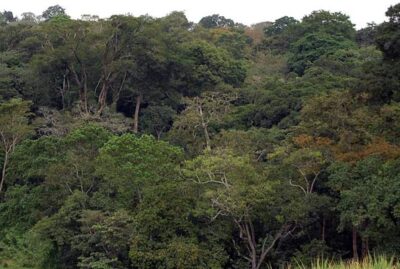
By Musa Polite
Over eight hundred (800) hectares of forests from the thirteen forest reserves in Kyenjiojo district are breathing a new life after Government’s collaborative forest management initiative yielding results.
What was originally the shape of the forest?
Between Two to three years back, the level of forest destruction was alarming with a lot of hectares destroyed for timber, charcoal burning, farming and other human activities, raising a big conservation concern. However this has gradually changed and restoration effort has seen at least 98% of the previously lost forest cover regaining according to the body entrusted to protect and conserve forest in Uganda, National Forestry authority.
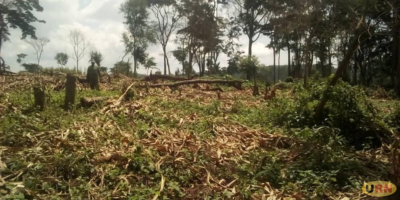 Part of Muhangi forest reserve in Kyenjojo district that was encroached on by maize growers before the restoration exercise. (Photo by Uganda Radio Network)
Part of Muhangi forest reserve in Kyenjojo district that was encroached on by maize growers before the restoration exercise. (Photo by Uganda Radio Network)
The national Forestry Authority through its restoration program has re-planted indigenous trees on over thirty eight hectares in places that were preciously destroyed by human activities while other places that were deserted after boundary opening are naturally re-generating, paving a new life for the natural resource.
The exercise that started with boundary re-opening on all the thirteen central forest reserves in the district since late 2021 With support from World Bank according to Mr. Milton Agaba, sector manager for Matili central forest reserve at NFA, has re- opened up boundaries and there are no longer issues of the community complaining about not knowing where their land boarders with the protected areas.
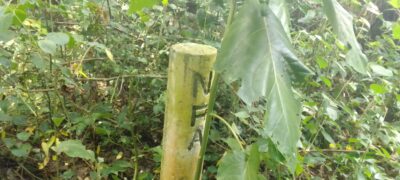
A pillar at one of the NFA land boundaries along Muzizi catchment area.
The district together with national forestry authority apart from Re-opening boundaries, they have also erected new pillars along the boundaries of all central forest reserves with demarcations of NFA, erected sign posts to create awareness of different forest reserves.
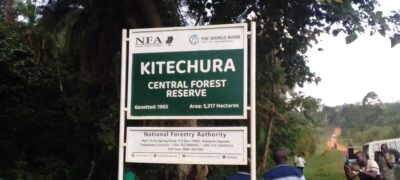
A sign post of Kitechura central forest reserve.
In another effort, Madam Ayesiga Julian Sarah, the Kyenjojo resident district commissioner says many places had been encroached on by the neighboring community and they are now doing restoration by planting indigenous tree species to recover the forest cover. ‘’In fact, in some areas like in the north East of Matili forest reserve, people had encroached on the forest close to forty (40) kilometers inside the forests, destroying the forest cover and planting perennial crops like coffee, tea while others had constructed houses. In fear that NFA could come for them, other people had encroached and gotten land tittles, though they had kept the green cover of the forest disguising that they are protecting the environment and in Some cases, people could illegally buy land in the middle of the forest unknowingly but we have cancelled their tittle.’’ The RDC asserted.
According to her, they have 18 people on remand and many others till in police custody over encroachment on the forest reserves. all this is intended to maintain the status quo of non encroachment.
Voice of Kyenjojo RDC Ayesiga Julian about conservation effort
If one visits along Muzizi catchment area in Ibambaala and Matili reserves Mr. Mwirumubi, one of the local environmentalists had moved into the forest 38 hectares, creating his own boundary.
The fate of encroachers
National forestry Authority spokesperson Mr. Aldon Walukamba says to create win – win situation, NFA along with their surveyors and ask people who have gotten illegal land tittles on the forest land to also hire their personal surveyors, they survey and get the right coordinates before erecting the pillars. He says almost all encroachers have voluntarily left after realizing they were the ones in mistake. He however decried of people who, even after demarcating the boundaries, they remove NFA pillars and continue doing agriculture in the would be protected area.
‘’For those that had planted perennial crops like coffee and others that had constructed houses, we give them grace period to vacate voluntarily and in case the time we give them elapses, the law must take its course.’’ Walukamba noted.
CFM
After boundary re-opening, erecting NFA marked pillars along the boundaries and restoration by re-planting indigenous trees in previously destroyed areas, NFA had to think of ways to effectively manage the forest without necessarily being at ‘cross roads’ with the neighborhood communities, here comes collaborative forest management.
Collaborative forest management (CFM) is loosely defined as a working partnership between the key stakeholders in the management of a given forest—key stakeholders being local forest users and state forest departments, as well as parties such as local governments, civic groups and nongovernmental organizations, and the private sector.
In the real sense, the people who previously used to rely on the forests for timber, charcoal and others agriculture in Matili, Kitecula and other areas mostly in Kitega sub county, the forestry body has formed community groups in different areas and through these groups, people have been given incentives to deter them from going back to the forest.

Kitega CFM group in a meeting with NFA officials at Kitega primary school
Kitega community environmental sensitive association was trained in bee keeping (apiary) and given 1350 bee hives to enable them earn income that was rather gotten from forest encroachment.
Barekye Jacob, LC3 chairperson Kitega Sub County says Kisenja and Buranga parishes were the most affected parts of the forest, applauding national forestry authority for its effort to educate locals on importance of the forest.
‘’People voluntarily left forests in exchange of such programs and many have collaborated, Left gardens that they had encroached on the forest and are now settling in the new life’ chairperson LC3 noted.

Some of the 1350 bee hives that NFA gave to Kitega community environmental sensitive association as part of incentives to deter them from relying on the forest entirely.
Syndicated encroachment
Angellas Mugarura, chairperson Kitega community environmental sensitive association that has 214 members says encroachment on the forest reserves has not only been done by locals only but there has been a syndicate between local people and outsiders who have been conniving to carry out charcoal burning and timber logging but with the initiation of the apiary project, many people have stopped helping outsiders into the forests, that’s why the forest is re-generating. According to him people have become watchdogs.
”Apart from forming groups to collaborate with NFA, we have turned into village saving cooperatives. we sit every week from our respective parishes and solicit money. We give to individuals according to individual problem. this has raised our incomes.” Noted Mugarura.
According to Mr. Mugarura, their association apart from apiary, they have received other training from national forestry authority under collaborative forest management and the trainings include liquid soap making and crafts and they intend to do piggery, poultry and fish farming to top up on those given by NFA for sustainability.
Jamimah Asiimwe from Isinda village in Kitega sub county re-echoes how they (community) have been conniving with people from other districts and helping them to carry out charcoal burning and timber logging, adding that since they were trained and given such projects like apiary and liquid soap making, they act as watchdogs and can’t allow anyone to illegally encroach on the forest because they fear NFA may withdraw the projects that are now seen as their next hope.
Under the terms of a CFM agreement, the groups take on specific responsibilities for example, forest patrolling and management, in exchange for specific benefits, for example, access to forest resources and forest land for tree growing. The responsible body, in turn, takes on the responsibly to support the CFM group and respect and deliver on agreed benefits Like for the case of Kyenjojo district.
In this, the time that locals would use to go and encroach on the forest, they use the same time to engage in developmental projects that have now become substitutes.
Jamimah Asiimwe betting bee hives.
Has CFM really worked?
Mr. Aldon Walukamba, National forestry authority spokesperson says before launching such projects, the forest cover was below ten percent (10%) but in entire Uganda, it has increased to over thirteen percent (13%), a clear indication that the interventions are working for both government of Uganda, district local governments and communities near the forests.
Asked what exactly the collaborative forest management is doing, Aldon noted that the program aims at afforestation to restore forest reserves, slow down degradation and promoting sustainable management of the forest reserves, all through collaborating with community established groups that were previously encroaching on the forests.
‘’The bigger the percentage we cover, the bigger the objectives achieved and so far in Kyenjojo district, Ninety eight percent (98%) has been achieved save a few cases of charcoal burning that we are working with police to stamp out.’’ Walukamba noted
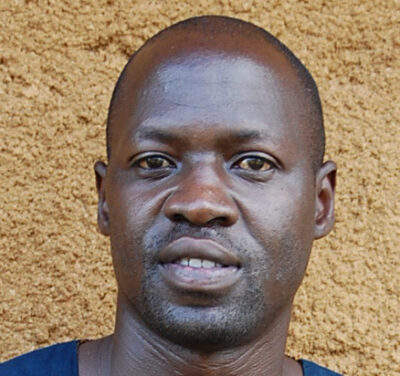 Mr. Aldon Walukamba, NFA Spokesperson
Mr. Aldon Walukamba, NFA Spokesperson
According to the ministry of water and environment, by 2001 Forests and woodlands covered approximately 4.9 million hectares in Uganda, about 24% of the total land area. The vast majority of this is woodland, while the remainder is tropical high forest and forestry plantations
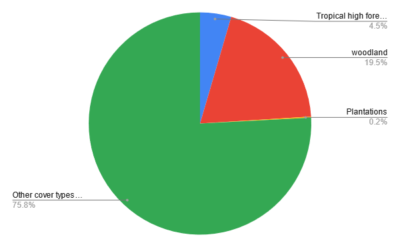
A Pie chart showing Total forest cover in Uganda
Pie chart of forest cover in Uganda
Ministry of Water and Environment’s Executive Summary on a review of collaborative forest management suggests that Uganda is facing an alarming deforestation rate. Between 1990 and 2015, forest cover declined from nearly one quarter to less than one tenth of the country’s land area.
Over the last 25 years, Uganda has lost about 60% of its standing forests and on average, over 100,000 hectares of forest are currently being lost annually yet Uganda’s forests hold critical biodiversity and are central to the country’s economy and people’s livelihoods, especially the 80% of the population living in rural areas and relying on rain-fed agriculture and natural resource utilization.
In such times like now when Urgent action is needed to enhance forest conservation and reforestation in ways that sustainably Support and improve rural livelihoods, Collaborative Forest Management can play a critical role in achieving these ends by establishing a mutually agreed upon and beneficial relationship between an eligible local community group and the governing authority of either a Central Forest Reserve or a Local Forest Reserve.
At the same time, CSOs will need to engage in lobby and advocacy to influence review of the national forestry policy, focusing on, among others, simplifying formalization procedures, and providing clearer stipulations for benefit sharing between the responsible government agency and the communities.


